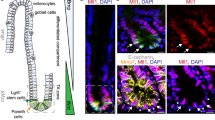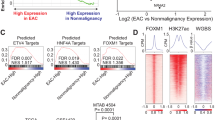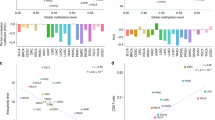Abstract
Runt domain transcription factor 3 (RUNX 3) is widely regarded as a tumour-suppressor gene inactivated by DNA hypermethylation of its canonical CpG (cytidine-phosphate-guanidine) island (CGI) promoter in gastric cancer (GC). Absence of RUNX3 expression from normal gastric epithelial cells (GECs), the progenitors to GC, coupled with frequent RUNX3 overexpression in GC progression, challenge this longstanding paradigm. However, epigenetic models to better describe RUNX3 deregulation in GC have not emerged. Here, we identify lineage-specific DNA methylation at an alternate, non-CGI promoter (P1) as a new mechanism of RUNX3 epigenetic control. In normal GECs, P1 was hypermethylated and repressed, whereas in immune lineages P1 was hypomethylated and widely expressed. In human GC development, we detected aberrant P1 hypomethylation signatures associated with the early inflammatory, preneoplastic and tumour stages. Aberrant P1 hypomethylation was fully recapitulated in mouse models of gastric inflammation and tumorigenesis. Cell sorting showed that P1 hypomethylation reflects altered cell-type composition of the gastric epithelium/tumour microenvironment caused by immune cell recruitment, not methylation loss. Finally, via long-term culture of gastric tumour epithelium, we revealed that de novo methylation of the RUNX3 canonical CGI promoter is a bystander effect of oncogenic immortalization and not likely causal in GC pathogenesis as previously argued. We propose a new model of RUNX3 epigenetic control in cancer, based on immune-specific, non-CGI promoter hypomethylation. This novel epigenetic signature may have utility in early detection of GC and possibly other epithelial cancers with premalignant immune involvement.
This is a preview of subscription content, access via your institution
Access options
Subscribe to this journal
Receive 50 print issues and online access
$259.00 per year
only $5.18 per issue
Buy this article
- Purchase on Springer Link
- Instant access to full article PDF
Prices may be subject to local taxes which are calculated during checkout







Similar content being viewed by others
References
Ferlay J, Soerjomataram I, Ervik M, Dikshit R, Eser S, Mathers C et al. GLOBOCAN 2012 v1.0, Cancer Incidence and Mortality Worldwide: IARC CancerBase No. 11 [Internet]. International Agency for Research on Cancer: Lyon, France, 2013.
Yeoh KG . How do we improve outcomes for gastric cancer? J Gastroenterol Hepatol 2007; 22: 970–972.
Correa P, Haenszel W, Cuello C, Tannenbaum S, Archer M . A model for gastric cancer epidemiology. Lancet 1975; 2: 58–60.
Schier S, Wright NA . Stem cell relationships and the origin of gastrointestinal cancer. Oncology 2005; 69 (Suppl 1): 9–13.
Hoffmann W . Self-renewal of the gastric epithelium from stem and progenitor cells. Front Biosci (Schol Ed) 2013; 5: 720–731.
Peterson AJ, Menheniott TR, O'Connor L, Walduck AK, Fox JG, Kawakami K et al. Helicobacter pylori infection promotes methylation and silencing of trefoil factor 2, leading to gastric tumor development in mice and humans. Gastroenterology 2010; 139: 2005–2017.
Schmid CA, Muller A . FoxD3 is a novel, epigenetically regulated tumor suppressor in gastric carcinogenesis. Gastroenterology 2013; 144: 22–25.
Ehrlich M . DNA methylation in cancer: too much, but also too little. Oncogene 2002; 21: 5400–5413.
Clark SJ, Melki J . DNA methylation and gene silencing in cancer: which is the guilty party? Oncogene 2002; 21: 5380–5387.
Sproul D, Nestor C, Culley J, Dickson JH, Dixon JM, Harrison DJ et al. Transcriptionally repressed genes become aberrantly methylated and distinguish tumors of different lineages in breast cancer. Proc Natl Acad Sci USA 2011; 108: 4364–4369.
Dedeurwaerder S, Fuks F . DNA methylation markers for breast cancer prognosis: unmasking the immune component. Oncoimmunology 2012; 1: 962–964.
Weber M, Hellmann I, Stadler MB, Ramos L, Paabo S, Rebhan M et al. Distribution, silencing potential and evolutionary impact of promoter DNA methylation in the human genome. Nat Genet 2007; 39: 457–466.
Schmidl C, Klug M, Boeld TJ, Andreesen R, Hoffmann P, Edinger M et al. Lineage-specific DNA methylation in T cells correlates with histone methylation and enhancer activity. Genome Res 2009; 19: 1165–1174.
Dedeurwaerder S, Desmedt C, Calonne E, Singhal SK, Haibe-Kains B, Defrance M et al. DNA methylation profiling reveals a predominant immune component in breast cancers. EMBO Mol Med 2011; 3: 726–741.
Hu M, Yao J, Cai L, Bachman KE, van den Brule F, Velculescu V et al. Distinct epigenetic changes in the stromal cells of breast cancers. Nat Genet 2005; 37: 899–905.
Westendorf JJ, Hiebert SW . Mammalian runt-domain proteins and their roles in hematopoiesis, osteogenesis, and leukemia. J Cell Biochem 1999; (Suppl 32-33): 51–58.
Lian JB, Javed A, Zaidi SK, Lengner C, Montecino M, van Wijnen AJ et al. Regulatory controls for osteoblast growth and differentiation: role of Runx/Cbfa/AML factors. Crit Rev Eukaryot Gene Expr 2004; 14: 1–41.
Levanon D, Bettoun D, Harris-Cerruti C, Woolf E, Negreanu V, Eilam R et al. The Runx3 transcription factor regulates development and survival of TrkC dorsal root ganglia neurons. EMBO J 2002; 21: 3454–3463.
Woolf E, Xiao C, Fainaru O, Lotem J, Rosen D, Negreanu V et al. Runx3 and Runx1 are required for CD8 T cell development during thymopoiesis. Proc Natl Acad Sci USA 2003; 100: 7731–7736.
Taniuchi I, Osato M, Egawa T, Sunshine MJ, Bae SC, Komori T et al. Differential requirements for Runx proteins in CD4 repression and epigenetic silencing during T lymphocyte development. Cell 2002; 111: 621–633.
Fainaru O, Woolf E, Lotem J, Yarmus M, Brenner O, Goldenberg D et al. Runx3 regulates mouse TGF-beta-mediated dendritic cell function and its absence results in airway inflammation. EMBO J 2004; 23: 969–979.
Lai CB, Mager DL . Role of runt-related transcription factor 3 (RUNX3) in transcription regulation of natural cytotoxicity receptor 1 (NCR1/NKp46), an activating natural killer (NK) cell receptor. J Biol Chem 2012; 287: 7324–7334.
Levanon D, Negreanu V, Lotem J, Bone KR, Brenner O, Leshkowitz D et al. Runx3 regulates interleukin-15 dependent natural killer cell activation. Mol Cell Biol 2014; 34: 1158–1169.
Li QL, Ito K, Sakakura C, Fukamachi H, Inoue K, Chi XZ et al. Causal relationship between the loss of RUNX3 expression and gastric cancer. Cell 2002; 109: 113–124.
Fan XY, Hu XL, Han TM, Wang NN, Zhu YM, Hu W et al. Association between RUNX3 promoter methylation and gastric cancer: a meta-analysis. BMC Gastroenterol 2011; 11: 92.
Subramaniam MM, Chan JY, Yeoh KG, Quek T, Ito K, Salto-Tellez M . Molecular pathology of RUNX3 in human carcinogenesis. Biochim Biophys Acta 2009; 1796: 315–331.
Levanon D, Bernstein Y, Negreanu V, Bone KR, Pozner A, Eilam R et al. Absence of Runx3 expression in normal gastrointestinal epithelium calls into question its tumour suppressor function. EMBO Mol Med 2011; 3: 593–604.
Salto-Tellez M, Peh BK, Ito K, Tan SH, Chong PY, Han HC et al. RUNX3 protein is overexpressed in human basal cell carcinomas. Oncogene 2006; 25: 7646–7649.
Li J, Kleeff J, Guweidhi A, Esposito I, Berberat PO, Giese T et al. RUNX3 expression in primary and metastatic pancreatic cancer. J Clin Pathol 2004; 57: 294–299.
Kudo Y, Tsunematsu T, Takata T . Oncogenic role of RUNX3 in head and neck cancer. J Cell Biochem 2011; 112: 387–393.
Hu SL, Huang DB, Sun YB, Wu L, Xu WP, Yin S et al. Pathobiologic implications of methylation and expression status of Runx3 and CHFR genes in gastric cancer. Med Oncol 2011; 28: 447–454.
Gardiner-Garden M, Frommer M . CpG islands in vertebrate genomes. J Mol Biol 1987; 196: 261–282.
Han H, Cortez CC, Yang X, Nichols PW, Jones PA, Liang G . DNA methylation directly silences genes with non-CpG island promoters and establishes a nucleosome occupied promoter. Hum Mol Genet 2011; 20: 4299–4310.
Jackson CB, Judd LM, Menheniott TR, Kronborg I, Dow C, Yeomans ND et al. Augmented gp130-mediated cytokine signalling accompanies human gastric cancer progression. J Pathol 2007; 213: 140–151.
Coolen MW, Statham AL, Gardiner-Garden M, Clark SJ . Genomic profiling of CpG methylation and allelic specificity using quantitative high-throughput mass spectrometry: critical evaluation and improvements. Nucleic Acids Res 2007; 35: e119.
Biondo M, Nasa Z, Marshall A, Toh BH, Alderuccio F . Local transgenic expression of granulocyte macrophage-colony stimulating factor initiates autoimmunity. J Immunol 2001; 166: 2090–2099.
Judd LM, Alderman BM, Howlett M, Shulkes A, Dow C, Moverley J et al. Gastric cancer development in mice lacking the SHP2 binding site on the IL-6 family co-receptor gp130. Gastroenterology 2004; 126: 196–207.
Keshet I, Schlesinger Y, Farkash S, Rand E, Hecht M, Segal E et al. Evidence for an instructive mechanism of de novo methylation in cancer cells. Nat Genet 2006; 38: 149–153.
Smiraglia DJ, Rush LJ, Fruhwald MC, Dai Z, Held WA, Costello JF et al. Excessive CpG island hypermethylation in cancer cell lines versus primary human malignancies. Hum Mol Genet 2001; 10: 1413–1419.
Landan G, Cohen NM, Mukamel Z, Bar A, Molchadsky A, Brosh R et al. Epigenetic polymorphism and the stochastic formation of differentially methylated regions in normal and cancerous tissues. Nat Genet 2012; 44: 1207–1214.
Schlesinger Y, Straussman R, Keshet I, Farkash S, Hecht M, Zimmerman J et al. Polycomb-mediated methylation on Lys27 of histone H3 pre-marks genes for de novo methylation in cancer. Nat Genet 2007; 39: 232–236.
Fujii S, Ito K, Ito Y, Ochiai A . Enhancer of zeste homologue 2 (EZH2) down-regulates RUNX3 by increasing histone H3 methylation. J Biol Chem 2008; 283: 17324–17332.
Weber M, Davies JJ, Wittig D, Oakeley EJ, Haase M, Lam WL et al. Chromosome-wide and promoter-specific analyses identify sites of differential DNA methylation in normal and transformed human cells. Nat Genet 2005; 37: 853–862.
Esteller M, Corn PG, Baylin SB, Herman JG . A gene hypermethylation profile of human cancer. Cancer Res 2001; 61: 3225–3229.
So K, Tamura G, Honda T, Homma N, Endoh M, Togawa N et al. Quantitative assessment of RUNX3 methylation in neoplastic and non-neoplastic gastric epithelia using a DNA microarray. Pathol Int 2006; 56: 571–575.
Brenner O, Levanon D, Negreanu V, Golubkov O, Fainaru O, Woolf E et al. Loss of Runx3 function in leukocytes is associated with spontaneously developed colitis and gastric mucosal hyperplasia. Proc Natl Acad Sci USA 2004; 101: 16016–16021.
Sugai M, Aoki K, Osato M, Nambu Y, Ito K, Taketo MM et al. Runx3 is required for full activation of regulatory T cells to prevent colitis-associated tumor formation. J Immunol 2011; 186: 6515–6520.
Whitehead RH . Establishment of cell lines from colon carcinoma. In: Freshney IR (ed). Culture of Human Tumor Cells. John Wiley and Sons: New York, NY, USA, 2003, pp 68–80.
Huber M, Helgason CD, Damen JE, Liu L, Humphries RK, Krystal G . The src homology 2-containing inositol phosphatase (SHIP) is the gatekeeper of mast cell degranulation. Proc Natl Acad Sci USA 1998; 95: 11330–11335.
Kalesnikoff J, Galli SJ . Antiinflammatory and immunosuppressive functions of mast cells. Methods Mol Biol 2011; 677: 207–220.
Menheniott TR, Peterson AJ, O'Connor L, Lee KS, Kalantzis A, Kondova I et al. A novel gastrokine, Gkn3, marks gastric atrophy and shows evidence of adaptive gene loss in humans. Gastroenterology 2010; 138: 1823–1835.
Levanon D, Brenner O, Negreanu V, Bettoun D, Woolf E, Eilam R et al. Spatial and temporal expression pattern of Runx3 (Aml2) and Runx1 (Aml1) indicates non-redundant functions during mouse embryogenesis. Mech Dev 2001; 109: 413–417.
Lee KS, Kalantzis A, Jackson CB, O'Connor L, Murata-Kamiya N, Hatakeyama M et al. Helicobacter pylori CagA triggers expression of the bactericidal lectin REG3gamma via gastric STAT3 activation. PLoS ONE 2012; 7: e30786.
Acknowledgements
We thank Professor Y Groner and Dr D Levanon (The Weizmann Institute of Science, Rehovot, Israel) for their gift of anti-Runx3 antiserum and critical reviews of the manuscript. We thank Professor I van Driel (University of Melbourne, Australia) for providing H+/K+ ATPase-gmcsf transgenic mice and Professor M Ernst (Walter and Eliza Hall Institute of Medical Research, Melbourne, Australia) for providing gp130F/F mice. We thank Dr J Däbritz (Murdoch Children’s Research Institute) for critically reviewing the manuscript. This work was supported by a project grant (1006542) awarded to TRM by the National Health and Medical Research Council (NH&MRC) of Australia and by the Victorian Government’s Medical Research Operational Infrastructure Program.
Author Contributions
TRM, ASG, LMJ and JRM conceived, designed and led the study. BK, TRM, EK and RHW performed the experiments. BK and TRM analysed the data. TM and JGF contributed reagents and materials. TRM and BK wrote the manuscript. TRM, ASG, LMJ and JRM edited and revised the manuscript. All authors approved the final version of the manuscript before submission
Author information
Authors and Affiliations
Corresponding author
Ethics declarations
Competing interests
The authors declare no conflict of interest.
Additional information
Supplementary Information accompanies this paper on the Oncogene website
Rights and permissions
About this article
Cite this article
Kurklu, B., Whitehead, R., Ong, E. et al. Lineage-specific RUNX3 hypomethylation marks the preneoplastic immune component of gastric cancer. Oncogene 34, 2856–2866 (2015). https://doi.org/10.1038/onc.2014.233
Received:
Accepted:
Published:
Issue Date:
DOI: https://doi.org/10.1038/onc.2014.233



